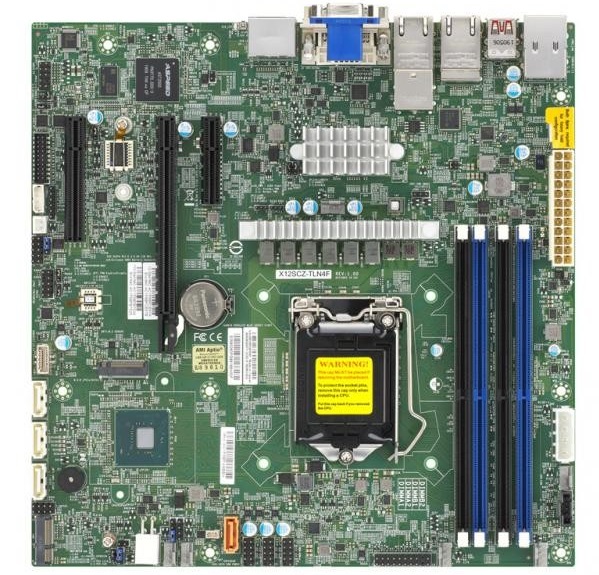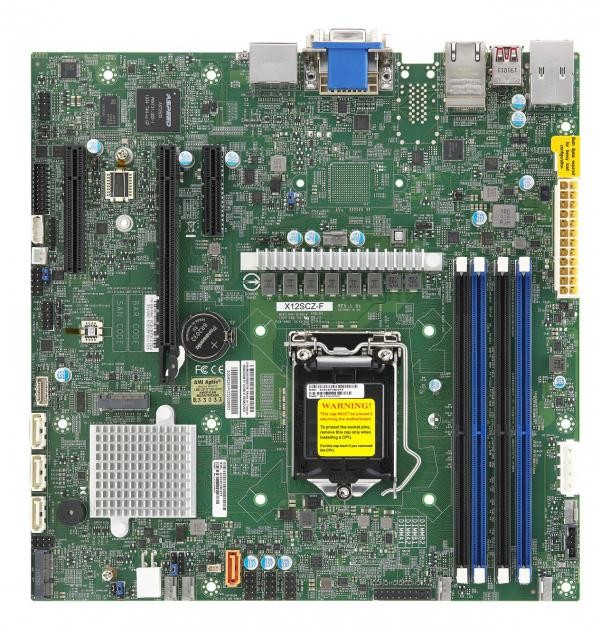The Intel W480 Motherboard Overview: LGA1200 For Xeon W-1200
by Gavin Bonshor on June 24, 2020 9:00 AM ESTSupermicro X12SCZ-TLN4F & X12SCZ-F
For the launch and release of Intel's W480 chipset, Supermicro has prepared a handful of models, each with different configurations to cater to various user needs. Two of Supermicro's W480 models come via the X12SCZ-F and X12SCZ-TLN4F, which share the same core micro-ATX PCB layout, with its green PCB, and black and blue slots. The only difference between both models aside from a few visual differences comes in the controller set. The Supermicro X12SCZ-TLN4F includes dual Intel 10 GbE Ethernet, a single PCIe 3.0 x4 M.2, and four SATA, while the X12SCZ-F opts for dual Gigabit Ethernet.

Supermicro X12SCZ-TLN4F micro-ATX motherboard
Visually, there's not much difference between the Supermicro X12SCZ-F and X12SCZ-TLN4F aside from the heatsink layout. On the latter, there's a heatsink cooling the Intel X550 10 GbE T-Base dual Ethernet controller, while the X12SCZ-F has a heatsink cooling the W480 chipset. This also includes a transposed socket design for installation into rackmount and 1U chassis. Aside from the networking and the onboard audio, both models are identical in specification and design. This includes one full-length PCIe 3.0 x16 slot, with a half-length PCIe 3.0 x4 slot, and a single PCIe 3.0 x1 slot. For storage, there's one PCIe 3.0 x4 M.2 slot, with four SATA ports with support for RAID 0, 1, 5, and 10 arrays. An additional PCIe 3.0 x1 M.2 Key-E slot is also present on both boards.
Focusing on memory support, both the X12SCZ-TLN4F and X12SCZ-F includes four memory slots, with support for up to DDR4-2933 of ECC and non-ECC memory, with a maximum capacity of up to 128 GB. Both models also include an Aspeed AST2500 BMC controller with a D-sub to access the IPMI physically. Supermicro also features memory error detection with the detection of double-bit errors using ECC memory and the correction of single-bit memory errors across all memory types used.

Supermicro X12CZ-F micro-ATX motherboard
As previously mentioned, the only difference between both models is that the X12CZ-TLN4F opts for an Intel X550 10 GbE T-Base dual Ethernet controller, with two additional Ethernet ports with one controlled by an Intel I219LM controller, and another by an Intel I120-AT. The Supermicro X12SCZ-F includes two Ethernet controllers consisting of an Intel I219LM and I210-AT Gigabit controller pairing. Both models include four USB 3.2 G2 Type-A ports, with two DisplayPort video inputs, a D-sub for the boards IPMI, and a serial port. Both models use a Realtek ALC888S HD audio codec for the onboard audio, but Supermicro doesn't specify how this translates to rear panel audio connections.
The Supermicro X12CZ-TLN4F includes superior networking support with dual Gigabit Ethernet ports and a dual 10 GbE T-Base Ethernet, while the X12CZ-F opts for dual Gigabit Ethernet. Both models include a solid professional feature set including an Aspeed AST2500 BMC controller which allows IPMI access physically via a D-sub video output, or via remote access which includes KVM support. Supermicro at present hasn't unveiled pricing on any of its W480 models, as it expects to sell them to system integrators only.










38 Comments
View All Comments
timecop1818 - Wednesday, June 24, 2020 - link
nobody cares about pcie4, and definitely not the target audience for this cpu/boards.PixyMisa - Wednesday, June 24, 2020 - link
Intel doesn't offer PCIe 4.0 on any of their CPUs yet. Not even Cooper Lake, which launched last week.Foeketijn - Thursday, June 25, 2020 - link
Even if they would be PCIe 2.0 they would sell. Current xeon servers are still also sold with iron drives.The box will say, Intel and Xeon, Windows server will run on it, and the barebone is less then 600 bucks. All potential customer needs.
Foeketijn - Thursday, June 25, 2020 - link
Because the whole server is going to cost way less then 1 Epyc CPU.dragosmp - Wednesday, June 24, 2020 - link
DFII fondly remember a Lanparty Nforce4 AM2 board
Most their good folks went to Biostar, I seem to remember, and then to Gigabyte. Glad to see they're still around as a company, although they may not have anything to do with the DFI of old
Foeketijn - Thursday, June 25, 2020 - link
Ah, a man of culture! Those where the hardware times. The times when the chipset mattered, and the latest CPU could do things you couldn't do with last years CPU. When the midrange GPU was affordable and still beat last years high end GPU.Having said that. On the CPU front AMD is making life interesting a bit lately.
bolkhov - Wednesday, June 24, 2020 - link
Gavin,Regarding Supermicro X12SAE: it is NOT the only ATX W480 model from Supermicro; the second one is X12SCA-F. Its main difference is BMC (hence the "-F"), thus, the IPMI/BMC mentioned in X12SAE docs are about X12SCA-F.
In X11 lineup these mobos' predecessors were X11SAE/X11SAE-F (Skylake/Kaby) and X11SCA/X11SCA-F (Coffee). For some unknown reason in the X12 lineup this pair was separated, and current Supermicro's site is, to put it mildly, not very informative/straightforward/useful (previous version had much better information accessibility), so it isn't easy to grasp the whole W480 lineup.
Foeketijn - Thursday, June 25, 2020 - link
This chipset is for people who need a server. Which CPU? Intel I guess.I am wondering why so many motherboard are made. Maybe because they are a drop in replacement for the consumer chipset. So R&D cost are minimal.
In the end 99% of those chipsets are sold by HP/Dell/Lenovo in less then 1000 bucks windows server boxes.
If only those 3 would make the same Ryzen based servers like Asrockrack. Then still the bulk would be intel, since in this branch, hardware minded people are scarce (you did your 3 year IT course, and now you can maintain a Windows Server, as long everything goes as planned).
bolkhov - Thursday, June 25, 2020 - link
BTW, regarding ASUS Pro WS W480-Ace:according to User Manual, two Display Port connectors on the rear panel are NOT outputs, but are INPUTS, for those TB3s. Probably to connect discrete GPU outputs, for those to be tunneled to TB3s.
Dunno if iGPU output pipes are routed to TB3s internally or if HDMI is the only iGPU output; the User Manual keeps silence about it.
Mr Perfect - Saturday, June 27, 2020 - link
That ASRock W480 Creator has the most impressive rear IO I've ever seen. Why don't high end desktop boards have a set like that?